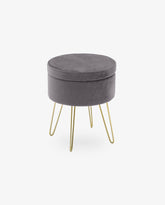Is It Okay to Meditate in a Moveable Office Chair?
Mindfulness meditation has gone mainstream and become the fastest growing health trend these years. The number of people in U.S. turning to meditation is skyrocketing - over 14% of US adults have tried meditation at least once according to the official research from NIH. Why is meditation so popular? Why should we be mindful?
What are Meditation and Mindfulness?
Meditation has a history tracing back to Harappan Civilization as early as 5,000 BCE in the Indus Valley - some archaeologists discovered the wall art depicting people sitting in typical meditation postures. When it comes to "Meditation", we're talking about a diversity of practices focusing on mind and body integration, which helps you cope with stress, stay centered and keep inner peace, thus enhancing overall well-being.
There are literally hundreds of types of meditations. Some forms are about maintaining mental focus on your particular sensation, using your eye, nose, mouth, or ears to pay full attention to a visual image, your breathing, a mantra or a sound. While the rest are targeted on the practices of mindfulness, which means maintaining awareness on the time being only, and without any judgments, objectively and rationally.

What are the Benefits of Meditation?
Nowadays, we have so many distractions, stress and pressure on us. Our minds and thoughts are all over the place and we can hardly give full attention to the current moment. For those who experience anxiety and worries a lot, meditation in chaos can hep you move into a more positive frame of mind - finally benefiting both your psychological stability and your overall health. Anytime you need to access a deep inner state of peace and calm, do meditation! Although meditation isn't a cure-all, it could be the most effective way to slow down racing thoughts, let go of negativity and help you achieve peace of mind and body.
"Lotus" - the Best Meditation Posture? No-No, It Depends.
So how to sit in meditation? You might think of the classic "Lotus" position - sitting with your legs twisted into a pretzel shape. If you've heard about the origin of meditation - Buddha found his path to enlightenment with leg-crossed sitting under the Bodhi Tree over 2,500 years ago, you might think "If the masters - Buddhist monks sit in Lotus position and became enlightened, I should do that too."
Yes, Buddhist monks sit crossed-legged, but they are trained to do so and feel comfortable most of the time. It's quite similar to the fact that many Americans can't do Asian Squat. Most adults in the west cannot sit with legs crossed as well. Plus, although sitting with your legs crossed helps create a sense of stability, it could also put your knees at risk, especially if you had bad knees already. So here we won't talk too much about the difficult postures in this blog post - NOT for the beginners whether it's Quarter Lotus, Half Lotus (Ardha Padmasana), Full Lotus (Padmasana), Burmese Position (Siddhasana/Muktasana) or the traditional kneeling - Seiza (Vajrasana).

Can I Meditate Sitting in a Chair?
You may feel stiff, creaky and fidgety when getting down on the floor, especially when you've been used to the relative luxury of a chair. For those meditation beginners like you and me, yes, it is perfectly acceptable to sit on a chair. Without any potential harm to your knees! And you can enjoy all the benefits of meditation with a chair that sitting cross legged may bring. Mediating on a chair will also reduce judgement of yourself and others so that you can refocus attention on yourself and wait for the enlightenment to follow. A brilliantly comfortable chair enables you to improve your seated meditation posture. That's why we encourage you to learn how to meditate on a chair.
You Don't Need a Specially Adjustable Meditation Chair
Is a meditation chair with back necessary? What is the best meditation chair? If you're new to meditation, and not sure how long this passion will last, just use the existing chair you've owned! There's no need to spend hundreds of bucks to buy another meditation room furniture including a meditation chair with back support, custom-made, adjustable or with thick cushion. The truth is the professional meditation chairs are generally made for an "average" person. Go grab a simple wooden meditation dining chair or a normal office chair for the first try.
Choose a most comfortable meditation chair in your house to keep your back upright and straight, so you can stay awake and find a balance of calm and alertness. Professional meditation chairs are rarely built to be adjustable enough to meet all your individual needs and personal physique. There's no one-size-fits-all meditation chairs to boost your meditating sessions. But if slouching is how you normally sit, your back muscles aren't very strong or you're suffering from some back pain, it helps to add a cushion, rolled-up sweatshirt or a blanket for extra support to alleviate any discomfort you might feel when meditating.

How to Meditate Sitting on a Moveable Office Chair?
Before starting your journey of meditations from a moveable chair, keep it in mind: good posture is the key! If you sit in a painful way, you'll feel distracted and hard to pull your awareness back. Your posture in a meditation style office chair is incredibly significant. Not just for your body, but for your mind too. If it's not comfortable, it's not the right position. By checking four vital parts as below - spine, chin, shoulders and hands, you can easily find if you're in the best meditation position.
Spine: Let Your Spine Be Like a Stack of Coins
In classic Buddhist texts, it's highly recommended to make sure your spine be erect with the spinal vertebrae held as a stack of coins. Don't hunch or slouch as usual anymore! Sit like a tree rooted deeply into the earth. And set yourself closer to the edge of meditation desk chair so you can get an upright spine. Just imagine - you're a puppet on the string! There is a piece of string attached to the center of your crown of head, lifting your head upwards gently and keeping your spine elongated. As for the lower back, you can maintain a slight natural lordotic curve to avoid back pain.
Chin & Jaw: Tuck Your Chin in and Relax Your Jaw
Don't lean your neck forward, but keep your chin tucked in a little bit - approximately 20 degrees downwards. Keep your neck completely relaxed and the back of your neck flattened slightly. Then invite your jaw to relax - starting by repeating side-to-side movements gently. You can also close and open your mouth wide, fake some exaggerated yawns to release any built-up tension you're holding in your jaw. Ensure you can get clear breathing and slow down the swallowing process before mediation on the office chair with back.

Shoulders: Find Your Center and Keep Shoulders Symmetrical
Loose or drop down your shoulders and let your limbs hang naturally. Now you'll get an open chest, allowing for the free flow of breath. The best meditation posture is to get a perfect balance in your center of gravity. To find that place exactly in the middle, you can gently rock from side to side, front to back and around.
Hands: Resting on Knees with or without Mudras
Keep your hands placed on your knees or in your lap, or by your sides. It's up to you whether to have any symbolic hand positioning called mudras or not. But make sure the hands are a mirror image of each other with perfect symmetry. Try and adjust till you figure out which posture is most suited for you. Any hand position allowing you to maintain a balance of body - neither too forward nor too backward would be the best. Once you have it, avoid moving or changing position during the meditation.
Final Words:
Or if you are not such a "chair person", yes, you can stand up, lie down or even walking to meditate instead. But even when lying down, you still need proper meditation posture. Think about your body, and your preferences, and pick the right postures or suitable chairs for you. Happy meditating.
What are Meditation and Mindfulness?
Meditation has a history tracing back to Harappan Civilization as early as 5,000 BCE in the Indus Valley - some archaeologists discovered the wall art depicting people sitting in typical meditation postures. When it comes to "Meditation", we're talking about a diversity of practices focusing on mind and body integration, which helps you cope with stress, stay centered and keep inner peace, thus enhancing overall well-being.
There are literally hundreds of types of meditations. Some forms are about maintaining mental focus on your particular sensation, using your eye, nose, mouth, or ears to pay full attention to a visual image, your breathing, a mantra or a sound. While the rest are targeted on the practices of mindfulness, which means maintaining awareness on the time being only, and without any judgments, objectively and rationally.

Image by Conscious Design from Unsplash
What are the Benefits of Meditation?
Nowadays, we have so many distractions, stress and pressure on us. Our minds and thoughts are all over the place and we can hardly give full attention to the current moment. For those who experience anxiety and worries a lot, meditation in chaos can hep you move into a more positive frame of mind - finally benefiting both your psychological stability and your overall health. Anytime you need to access a deep inner state of peace and calm, do meditation! Although meditation isn't a cure-all, it could be the most effective way to slow down racing thoughts, let go of negativity and help you achieve peace of mind and body.
"Lotus" - the Best Meditation Posture? No-No, It Depends.
So how to sit in meditation? You might think of the classic "Lotus" position - sitting with your legs twisted into a pretzel shape. If you've heard about the origin of meditation - Buddha found his path to enlightenment with leg-crossed sitting under the Bodhi Tree over 2,500 years ago, you might think "If the masters - Buddhist monks sit in Lotus position and became enlightened, I should do that too."
Yes, Buddhist monks sit crossed-legged, but they are trained to do so and feel comfortable most of the time. It's quite similar to the fact that many Americans can't do Asian Squat. Most adults in the west cannot sit with legs crossed as well. Plus, although sitting with your legs crossed helps create a sense of stability, it could also put your knees at risk, especially if you had bad knees already. So here we won't talk too much about the difficult postures in this blog post - NOT for the beginners whether it's Quarter Lotus, Half Lotus (Ardha Padmasana), Full Lotus (Padmasana), Burmese Position (Siddhasana/Muktasana) or the traditional kneeling - Seiza (Vajrasana).

Can I Meditate Sitting in a Chair?
You may feel stiff, creaky and fidgety when getting down on the floor, especially when you've been used to the relative luxury of a chair. For those meditation beginners like you and me, yes, it is perfectly acceptable to sit on a chair. Without any potential harm to your knees! And you can enjoy all the benefits of meditation with a chair that sitting cross legged may bring. Mediating on a chair will also reduce judgement of yourself and others so that you can refocus attention on yourself and wait for the enlightenment to follow. A brilliantly comfortable chair enables you to improve your seated meditation posture. That's why we encourage you to learn how to meditate on a chair.
You Don't Need a Specially Adjustable Meditation Chair
Is a meditation chair with back necessary? What is the best meditation chair? If you're new to meditation, and not sure how long this passion will last, just use the existing chair you've owned! There's no need to spend hundreds of bucks to buy another meditation room furniture including a meditation chair with back support, custom-made, adjustable or with thick cushion. The truth is the professional meditation chairs are generally made for an "average" person. Go grab a simple wooden meditation dining chair or a normal office chair for the first try.
Choose a most comfortable meditation chair in your house to keep your back upright and straight, so you can stay awake and find a balance of calm and alertness. Professional meditation chairs are rarely built to be adjustable enough to meet all your individual needs and personal physique. There's no one-size-fits-all meditation chairs to boost your meditating sessions. But if slouching is how you normally sit, your back muscles aren't very strong or you're suffering from some back pain, it helps to add a cushion, rolled-up sweatshirt or a blanket for extra support to alleviate any discomfort you might feel when meditating.

How to Meditate Sitting on a Moveable Office Chair?
Before starting your journey of meditations from a moveable chair, keep it in mind: good posture is the key! If you sit in a painful way, you'll feel distracted and hard to pull your awareness back. Your posture in a meditation style office chair is incredibly significant. Not just for your body, but for your mind too. If it's not comfortable, it's not the right position. By checking four vital parts as below - spine, chin, shoulders and hands, you can easily find if you're in the best meditation position.
Spine: Let Your Spine Be Like a Stack of Coins
In classic Buddhist texts, it's highly recommended to make sure your spine be erect with the spinal vertebrae held as a stack of coins. Don't hunch or slouch as usual anymore! Sit like a tree rooted deeply into the earth. And set yourself closer to the edge of meditation desk chair so you can get an upright spine. Just imagine - you're a puppet on the string! There is a piece of string attached to the center of your crown of head, lifting your head upwards gently and keeping your spine elongated. As for the lower back, you can maintain a slight natural lordotic curve to avoid back pain.
Chin & Jaw: Tuck Your Chin in and Relax Your Jaw
Don't lean your neck forward, but keep your chin tucked in a little bit - approximately 20 degrees downwards. Keep your neck completely relaxed and the back of your neck flattened slightly. Then invite your jaw to relax - starting by repeating side-to-side movements gently. You can also close and open your mouth wide, fake some exaggerated yawns to release any built-up tension you're holding in your jaw. Ensure you can get clear breathing and slow down the swallowing process before mediation on the office chair with back.

Posture Checklist on an Office Chair
Shoulders: Find Your Center and Keep Shoulders Symmetrical
Loose or drop down your shoulders and let your limbs hang naturally. Now you'll get an open chest, allowing for the free flow of breath. The best meditation posture is to get a perfect balance in your center of gravity. To find that place exactly in the middle, you can gently rock from side to side, front to back and around.
Hands: Resting on Knees with or without Mudras
Keep your hands placed on your knees or in your lap, or by your sides. It's up to you whether to have any symbolic hand positioning called mudras or not. But make sure the hands are a mirror image of each other with perfect symmetry. Try and adjust till you figure out which posture is most suited for you. Any hand position allowing you to maintain a balance of body - neither too forward nor too backward would be the best. Once you have it, avoid moving or changing position during the meditation.
Final Words:
Or if you are not such a "chair person", yes, you can stand up, lie down or even walking to meditate instead. But even when lying down, you still need proper meditation posture. Think about your body, and your preferences, and pick the right postures or suitable chairs for you. Happy meditating.
Tags:
- can i meditate sitting in a chair
- can you do meditation in a chair
- can you meditate sitting in a chair
- how to meditate in a chair posture
- how to meditate sitting on a chair
- is it important to have a meditation chair
- is it okay to meditate in a chair
- is meditation chair necessary
- what do you learn from meditations from a movable chair
- what is the best meditation chair









